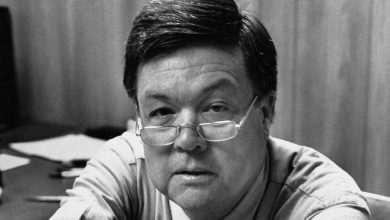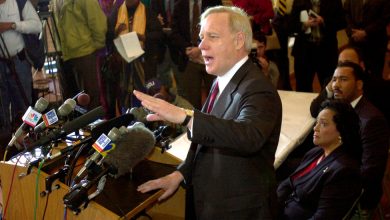Quoting Churchill and Shakespeare, Ukraine Leader Vows No Surrender

LONDON — With Ukraine’s outgunned army holding firm despite Russian bombardments that have displaced millions of civilians, the war in Ukraine has become a grim spectacle of resistance, no one more defiant than the country’s president, Volodymyr Zelensky, who vowed on Tuesday never to give in to Russia’s tanks, troops or artillery shells.
In a dramatic video address to Britain’s Parliament, clad in his now-famous military fatigue T-shirt, Mr. Zelensky echoed Winston Churchill’s famous words of no surrender to the same chamber at the dawn of World War II as Britain faced a looming onslaught from Nazi Germany.
“We will fight till the end, at sea, in the air,” Mr. Zelensky said with the blue-and-yellow Ukrainian flag draped behind him. “We will fight in the forests, in the fields, on the shores, in the streets.”
The speech, the first ever by a foreign leader to the House of Commons, was the climax of Mr. Zelensky’s darkest-hour messaging to fellow Ukrainians and the world in what has become a typical 20-hour day for him in Kyiv, the besieged capital.
In his daily speech to the nation, he claimed that Ukraine had inflicted 30 years of losses on Russia’s air force in 13 days. And in an internet video posted Monday night from his presidential office, he all but taunted President Vladimir V. Putin of Russia.
“I’m not hiding,” Mr. Zelensky said. “I’m not afraid of anyone.”
Nearly two weeks into Russia’s war, it was becoming ever clearer that the Kremlin’s military planners, not to mention Mr. Putin himself, had dramatically miscalculated not only the grit of Ukrainian resistance but also the calamitous economic consequences for Russia, which on Tuesday faced a major new embargo of its oil exports and a growing exodus of large American companies.
At the same time, the scope of the humanitarian disaster across Ukraine was growing by the hour, as were the reverberations among its European neighbors. Russian forces continued to batter Kyiv and other cities. In Mariupol, a strategically crucial port city surrounded by Russian forces, hundreds of thousands of people remained trapped without water, electricity and other basic services.
In his speech to British lawmakers, Mr. Zelensky reiterated his plea for the NATO alliance to impose a no-fly zone over Ukraine, something NATO leaders have ruled out because they fear it would could trigger a wider military clash between the West and Russia.
But the West further tightened the economic vise on Russia, with the United States and Britain announcing oil embargoes and a new raft of business suspensions by big-name American corporations including McDonald’s, Coca-Cola, Pepsico and Starbucks. McDonald’s move was especially noteworthy since the opening of the chain’s first outlet in the Soviet Union, on Pushkin Square in January 1990, was marked by throngs of Russians pushing and shoving to get inside and place their “Beeg Mek” orders.
“Now is not the time to let up,” Britain’s foreign secretary, Liz Truss, told reporters on Tuesday as she pledged that the world’s advanced industrialized countries would work out a timetable to reduce their dependence on Russian oil and gas.
Despite these statements of solidarity and Mr. Zelensky’s expressions of defiance, the war’s human cost has risen fearfully. The United Nations reported that more than two million Ukrainians — half of them children — had fled the country, the fastest-growing refugee crisis to afflict Europe since World War II.
Poland, a major recipient of the fleeing Ukrainians, said it was rushing to convert schools, churches and stadiums into temporary housing for them. “Shelters are being created rapidly,” said Piotr Bystrianin, head of the Ocalenie Foundation, a Polish refugee charity. “But it’s not enough.”
The Russian military’s invasion force, estimated to be roughly 200,000 troops when the war began on Feb. 24, had still not taken any major Ukrainian cities except the southern port of Kherson, despite repeated artillery and rocket barrages on other strategic urban centers. The targets included Mariupol and nearby Mykolaiv in the southeast, the eastern city of Kharkiv, and Kyiv, where Mr. Zelensky offered a video tour of his office on Monday evening.
Addressing British lawmakers on Tuesday, Mr. Zelensky offered a vivid, day-by-day summary of the misery Russia has wrought since it invaded. From the cruise-missile strikes that shattered the pre-dawn peace as the assault began to the panic of trapped residents in Mariupol, he painted a picture of a country in the grip of a humanitarian disaster.
“Everybody can hear that people don’t have water,” Mr. Zelensky said of those under siege in Mariupol. Russia’s shelling of hospitals and evacuation routes, he said, had killed scores of innocent civilians, including children.
“These are the children who could have lived,” he said to the packed and rapt chamber, “but they took them away from us.”
However long the odds Ukrainians faced or the horrors they were enduring, Mr. Zelensky said, they had made the decision to endure. To Shakespeare’s elemental question, “to be or not to be,” he said, Ukrainians had decided “to be.”
After days of failed evacuation efforts because of Russian attacks, at least one humanitarian corridor lasted long enough to allow hundreds of civilians to escape from Sumy, a war-battered city east of Kyiv. People left in a convoy of buses led by the Red Cross, despite shooting near the evacuation route, said Dmytro Zhyvytsky, governor of the region.
Among those brought to safety were about 700 students from India, the Indian government said. The students were headed to Poltava in central Ukraine and would then board trains to the western part of the country, according to India’s Foreign Ministry.
Almost since the first day of the war, the Ukrainian government has made efforts to evacuate people from cities under attack or under threat. The national rail service alone has transported more than one million people on special evacuation trains.
But attempts to open a humanitarian corridor in places of active fighting had mostly failed until now. Mr. Zelensky said the failure to open corridors to all seeking escape was a tragedy compounded by Ukraine’s vulnerability to the barrage of missiles and aerial bombardments launched by the Russians.
“The blame for every death of every person in Ukraine from airstrikes and in blocked cities is, of course, on the Russian state, on the Russian military,” he said in his daily speech to the nation. He implored Western nations to do more to help Ukraine secure “the Ukrainian sky from Russian assassins.”
Russia’s military superiority in size and weapons, however, has not insulated the invasion force from repeated losses and setbacks. While independent corroboration of battlefield claims is difficult, it was clear that Ukraine’s defenders had flustered the speed of the Russian advance.
Russia-Ukraine War: Key Things to Know
Russian oil imports. President Biden banned Russian oil, natural gas and coal imports into the United States. The move, which effectively shuts off the relatively small flow of Russian fuel into the country, could further rattle global energy markets and raise gas prices.
A halt to Russian sales. After days of seeming reluctance to take a stance over Russia’s invasion of Ukraine, three high-profile American food and beverage companies — McDonald’s, Coca-Cola and Starbucks — said they were pausing operations in Russia.
The key cities. Ukrainian military and civilian soldiers continued to bog down Russian forces, protecting the borders of key cities and inflicting heavy losses against the larger and better equipped Russian army.
A humanitarian crisis. Indiscriminate Russian shelling has trapped Ukrainian civilians and left tens of thousands without food, water, power or heat in besieged cities. The United Nations said that the number of refugees who have fled Ukraine has reached two million.
Since the start of the war, Ukraine’s military claims to have killed more than 12,000 Russian soldiers. Western officials said that number was high, though there had likely been several thousand Russian casualties.
In its latest daily update on Tuesday, the Ukrainian military said it had shot down or destroyed 48 Russian airplanes and 80 helicopters; captured or destroyed 303 tanks and hundreds of mechanized vehicles and cars; taken out two Russian naval vessels, including a warship; and blown up dozens of fuel tanker and mobile missile launching systems.
Satellite imagery analyzed by military analysts suggests that roughly 950 Russian vehicles, including 140 tanks, have been destroyed or damaged, according to Justin Bronk, a research fellow for air power and technology at the Royal United Services Institute, a London research group that specializes in security issues. That represents only a fraction of the invasion force, but it is still striking.
The intelligence arm of the Ukrainian Defense Ministry said on Tuesday that Maj. Gen. Vitaly Gerasimov, chief of staff of Russia’s 41st Army, had been killed outside Kharkiv, making him the second Russian general to die in the war.
The Ukrainians do not release a running tally of their own soldiers killed in action. But they often note the names of those who have died and bestow them with military honors. The Kremlin, on the other hand, has forbidden the media in Russia from calling the invasion a war — it is a “special military operation,” in Mr. Putin’s words — and officially, everything is going according to plan.
Of course, Ukraine and its Western allies see the promotion of Ukrainian victories as in their interest, and they tend to play up logistical and morale problems in the Russian ranks. By what American officials described as conservative estimates, Ukrainian soldiers have killed more than 3,000 Russian troops.
These officials, citing confidential United States intelligence assessments, said that Ukraine had also shot down military transport planes carrying Russian paratroopers, downed helicopters and blown holes in Russia’s convoys using American anti-tank missiles and armed drones supplied by Turkey.
Nonetheless, there is no sign that Mr. Putin will soften his approach to subjugate Ukraine, part of the Russian leader’s avowed intention to strengthen Russia against what he has described as an existential threat by the West.
At a briefing in Washington for Congress on Tuesday, the top American intelligence official, Avril D. Haines, told lawmakers that she expected Mr. Putin would be “essentially doubling down” in the invasion, to force Ukraine to disarm and proclaim neutrality.
Ms. Haines, the Biden administration’s director of national intelligence, said Mr. Putin “feels aggrieved the West does not give him proper deference and perceives this as a war he cannot afford to lose.”
Mark Landler reported from London, and Marc Santora from Lviv, Ukraine. Reporting was contributed by Rick Gladstone and Julie Creswell from New York, Dan Bilefsky from Montreal and Julian Barnes from Washington.




